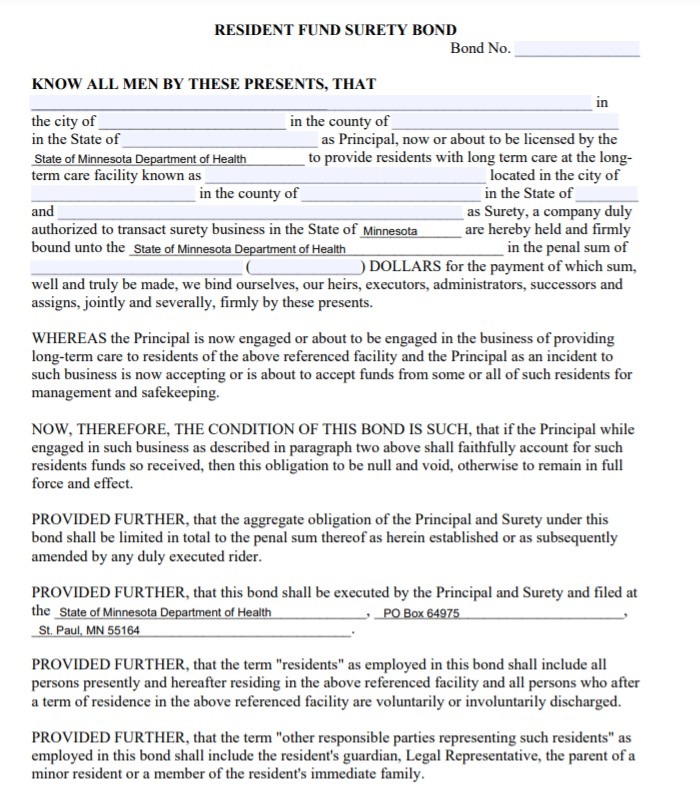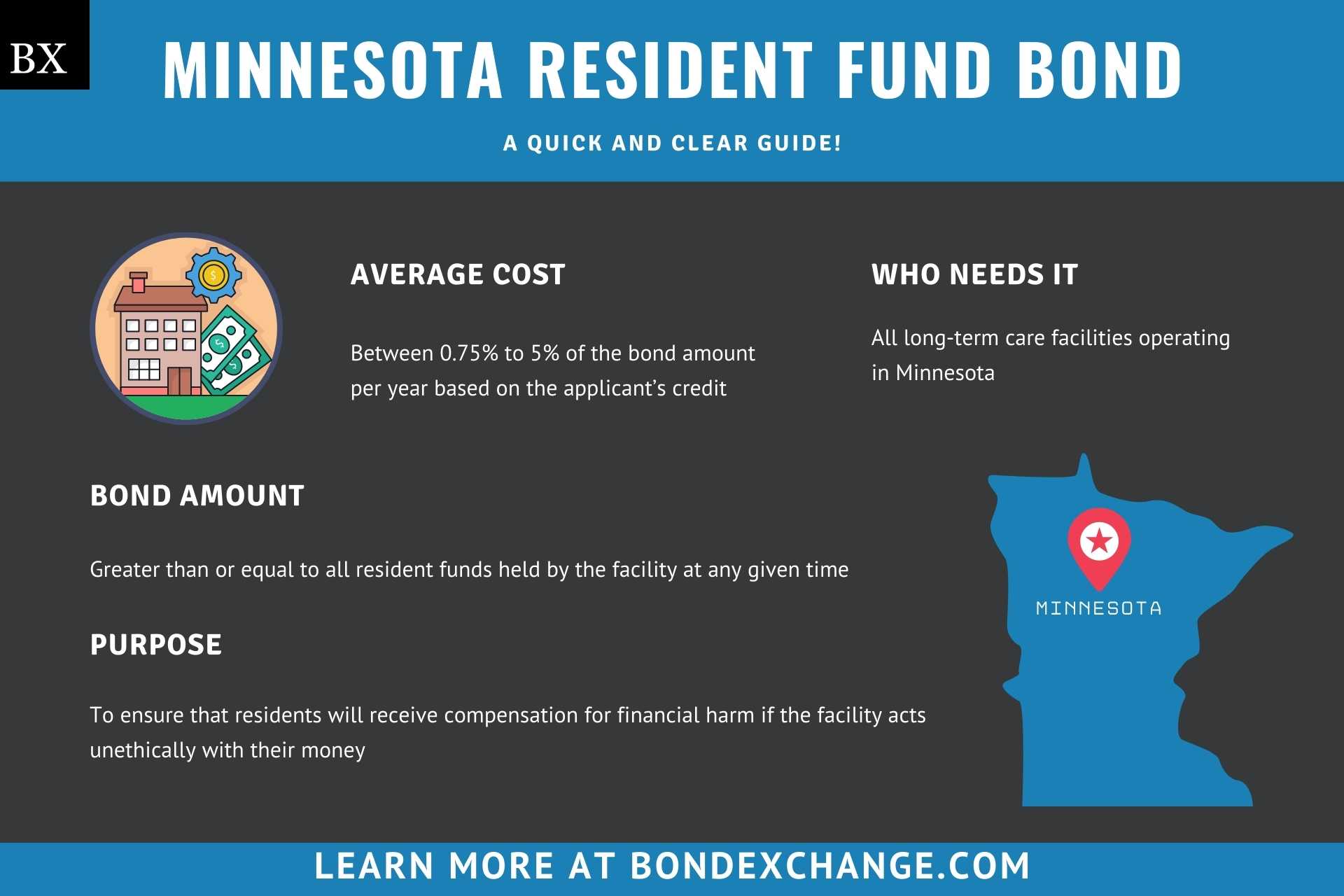Minnesota Resident Fund Bond: A Comprehensive Guide
This guide provides information for insurance agents to help their customers obtain Minnesota Resident Fund bonds
At a Glance:
- Lowest Cost: $150 per year or $15 per month, based on the applicant’s credit
- Bond Amount: Greater than or equal to all resident funds held by the facility at any given time
- Who Needs it: All long-term care facilities operating in Minnesota
- Purpose: To ensure that residents will receive compensation for financial harm if the facility acts unethically with their money
- Who Regulates Long-Term Care Facilities in Minnesota: The Minnesota Department of Health

Background
Minnesota statute 9505.0195 requires all long-term care facilities that receive Medicaid payments to enroll as a provider with the Department of Human Services. The Minnesota legislature enacted the enrollment requirement to ensure that eligible long-term care facilities receive compensation for services that are covered by Medicaid. To ensure residents are not taken advantage of, long-term care facilities that manage residents’ funds must purchase and maintain a surety bond to be eligible to receive Medicaid payments. Additionally, federal statute 483.10 requires all long-term care facilities that hold resident funds in a trust account to purchase a surety bond or other similar form of security. However, the federal regulation leaves the implementation and enforcement of this requirement to individual states.
What is the Purpose of the Minnesota Resident Fund Bond?
Minnesota requires each long-term care facility that manages resident funds to purchase a surety bond before enrolling as a Medicaid provider. The bond ensures that residents will receive compensation for financial harm if the facility fails to abide by the Federal Bill of Resident Rights. Specifically, the bond protects residents if the facility in any way mismanages their funds. In short, the bond is a type of insurance that protects residents if the long-term care facility acts unethically with their money.
How Can an Insurance Agent Obtain a Minnesota Resident Fund Surety Bond?
BondExchange makes obtaining a Minnesota Resident Fund bond easy. Simply log in to your account and use our keyword search to find the “resident fund” bond in our database. Don’t have a login? Gain access now and let us help you satisfy your customers’ needs. Our friendly underwriting staff is available by phone at (800) 438-1162, email, or chat from 7:30 AM to 7:00 PM EST to assist you.
At BondExchange, our 40 years of experience, leading technology, and access to markets ensures that we have the knowledge and resources to provide your clients with fast and friendly service whether obtaining quotes or issuing bonds.
Is a Credit Check Required for the Minnesota Resident Fund Bond?
Surety companies will run a credit check on the owners of the long-term care facility to determine eligibility and pricing for the Minnesota Resident Fund bond. Owners with excellent credit and work experience can expect to receive the best rates. Owners with poor credit may be declined by some surety companies or pay higher rates. The credit check is a “soft hit”, meaning that the credit check will not affect the owner’s credit.
How Much Does the Minnesota Resident Fund Bond Cost?
The Minnesota Resident Fund bond can cost anywhere between 0.75% to 5% of the bond amount per year. Insurance companies determine the rate based on several factors including your customer’s credit score and experience. BondExchange also offers monthly pay-as-you-go options for these bonds. The chart below offers a quick reference for the bond cost on a $20,000 bond requirement.
$20,000 Resident Fund Bond Cost
| Credit Score | Bond Cost (1 year) | Bond Cost (1 month) |
|---|---|---|
| 800+ | $150 | $15 |
| 625 – 799 | $200 | $20 |
| 600 – 624 | $500 | $50 |
| 575 – 599 | $600 | $60 |
| 500 – 574 | $1,000 | $100 |
Who is Required to Purchase the Minnesota Resident Fund Bond?
Minnesota requires each long-term care facility that manages resident funds to purchase a surety bond prior to enrolling as a Medicaid provider. Minnesota statute 9505.0015 defines “long-term care facility” as an institution that has been certified by the Minnesota Department of Health as either a skilled nursing or intermediate care facility.
Additionally, assisted living facilities are also required to purchase a resident fund bond.

BondExchange now offers monthly pay-as-you-go subscriptions for surety bonds. Your customers are able to purchase their bonds on a monthly basis and cancel them anytime. Learn more here.
How do Minnesota Long-Term Care Facilities Become Medicaid Providers?
Long-term care facilities in Minnesota must navigate several steps to complete their provider enrollment. Below are the general guidelines, but applicants should refer to the state’s Medicaid statutes for details on the process.
*The below steps focus exclusively on how to obtain a nursing home license and nursing facility Medicaid certification. For information regarding the licensure and enrollment processes for other long-term care facility types, click here.
Step 1 – Purchase a Surety Bond
Long-term care facilities that manage resident funds and receive Medicaid reimbursements must purchase and maintain a surety bond in an amount that is Greater than or equal to all resident funds held by the facility at any given time
Step 2 – Purchase Insurance
Nursing homes with employees must purchase workers’ compensation insurance
Step 3 – Obtain a Business License
Long-term care facilities are required to obtain a business license with the Department of Health before enrolling as a Medicaid provider. To secure a nursing home license, long-term care facilities must:
3.a Apply for a moratorium exception by emailing a letter of intent to [email protected]. Once their letter of intent is filed, long-term care facilities must upload their complete moratorium exception application to the Minnesota Department of Health CloudDrive. To gain access to the CloudDrive, long-term care facilities must send the name and email address of the facility’s administrator to [email protected].
Minnesota statute 144A.071 establishes a moratorium on the licensure of new nursing home beds and related construction projects exceeding $1 million. Subsequently, long-term care facilities seeking to license new beds and conduct construction projects must apply for an exemption to this rule.
3.b Mail a completed license application to the following address:
Minnesota Department of Health
Health Regulation Division
PO Box 64900
St. Paul, MN 55164-0900
Nursing homes must complete the application in its entirety, and submit an application fee equal to $183 + $110 per bed.
Step 4 – Enroll as a Medicaid Provider
Long-term care facilities are eligible to enroll as Medicaid providers after obtaining their business licenses. To enroll as a provider, long-term care facilities must:
4.a Get a National Provider Identifier (NPI) by registering with the NPPES
4.b Submit a completed enrollment application electronically here. Providers that wish to receive reimbursements via direct deposit can activate this service here.
How do Minnesota Long-Term Care Facilities Renew Their Licenses and Medicaid Enrollments?
Long-term care facilities should mail their completed license renewal application to the following address:
Minnesota Department of Health
Health Regulation Division
PO Box 64900
St. Paul, MN 55164-0900
All Minnesota Nursing Home Licenses expire one year from the date of issuance and must be renewed before the expiration date. Long-term care facilities will receive a revalidation notice containing instructions on how to revalidate their provider enrollments. All Minnesota long-term care facilities must revalidate their provider enrollments at least once every 5 years.
What are the Insurance Requirements for Long-Term Care Facilities in Minnesota?
Minnesota requires long-term care facilities with employees to purchase workers’ compensation insurance. Additionally, long-term care facilities that manage resident funds and receive Medicaid reimbursements must purchase and maintain a surety bond in an amount that is Greater than or equal to all resident funds held by the facility at any given time.
How Do Minnesota Long-Term Care Facilities File Their Bonds?
Long-term care facilities should mail their completed bond form, including the power of attorney, to the following address:
State of Minnesota Department of Health
PO Box 64975
St. Paul, MN 55164
The surety bond requires signatures from both the surety company that issues the bond and from a representative of the long-term care facility. The surety company should include the following information on the bond form:
- Legal name and location of entity/individual(s) buying the bond
- Surety company’s name and location
- Obligee’s name and location
- Bond amount
- Date the bond is signed
What Can Minnesota Long-Term Care Facilities Do to Avoid Claims Against Their Bonds?
To avoid claims on their bonds, long-term care facilities in Minnesota must ensure that they faithfully account for resident funds that they manage.
What Other Insurance Products Can Agents Offer Long-Term Care Facilities in Minnesota?
Minnesota requires long-term care facilities with employees to purchase workers’ compensation insurance. Additionally, most reputable facilities will purchase liability insurance as well. Bonds are our only business at BondExchange, so we do not issue any other types of insurance, but our agents often utilize brokers for this specific line of business. A list of brokers in this space can be found here.
How Can Insurance Agents Prospect for Minnesota Long-Term Care Facility Customers?
Minnesota conveniently provides a public database to search for active long-term care facilities in the state. The database can be accessed here. Contact BondExchange for additional marketing resources. Agents can also leverage our print-mail relationships for discounted mailing services.
